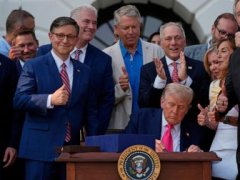WASHINGTON — On this day in 1965, President Lyndon B. Johnson signed legislation into law that launched Medicaid, creating a U.S. health care safety net for millions of low-income Americans in what would become one of the crowning achievements of his domestic legacy.
A year earlier, he did the same for food stamps, drawing on President John F. Kennedy’s first executive order for the development of “a positive food and nutrition program for all Americans.”
This summer, with the stroke of a pen, President Donald Trump began to chisel them back.
The Republican Party’s big tax and spending bill delivered not just $4.5 trillion in tax breaks for Americans but some of the most substantial changes to the landmark safety net programs in their history. The trade-off will cut more than $1 trillion over a decade from federal health care and food assistance, largely by imposing work requirements on those receiving aid and by shifting certain federal costs onto the states.
While Republicans in Congress argue the trims are needed to rightsize the federal programs that have grown over the decades and to prevent rising federal deficits, they are also moving toward a long-sought GOP goal of shrinking the federal government and the services it provides.
“We’re making the first changes to the welfare state in generations,” House Speaker Mike Johnson said in a recent podcast interview.
As the tax breaks and spending cuts law begins to take shape, it is unleashing a new era of uncertainty for the safety net programs that millions of people in communities across the nation have grown to depend on, with political ramifications to come.
Polling shows most U.S. adults don’t think the government is overspending on the programs. Americans broadly support increasing or maintaining existing levels of funding for popular safety net programs, including Social Security and Medicare, according to the poll from The Associated Press-NORC Center for Public Affairs Research.
Local governments are scrambling to figure out how they will comply with the new landscape, calculating whether they will need to raise their own taxes to cover costs, trim budgets elsewhere or cut back the aid provided to Americans.
“The cuts are really big, they are really broad and they are deeply damaging,” said Sharon Parrott, president of the Center for Budget and Policy Priorities, a research institute in Washington.
“The consequences are millions of people losing health care coverage,” she said. “Millions of people losing food assistance. And the net result of that is higher poverty, more hardship.”
At the same time, certain people who receive aid, including parents of teenagers and older Americans up to age 64, will have to prepare to work, engage in classes or do community service for 80 hours a month to meet new requirements.
All told, the nonpartisan Congressional Budget Office estimates 10 million more people will end up without health insurance. Some 3 million fewer people will participate in the Supplemental Nutritional Assistance Program, known as SNAP.
“People are really concerned what this means for their fiscal health,” said Mark Ritacco, chief governmental affairs officer at the National Association of Counties, which held its annual conference the week after Trump signed the bill into law.
The organization had pushed senators to delay the start dates for some Medicaid changes, and it hopes that further conversations with lawmakers in Congress can prevent some of them from ever taking hold. At its con





